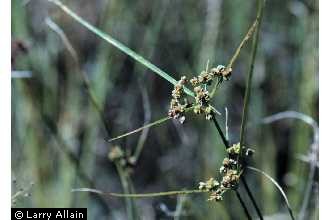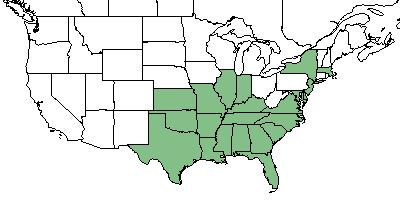Difference between revisions of "Cyperus pseudovegetus"
(→Distribution) |
(→Ecology) |
||
| Line 30: | Line 30: | ||
==Ecology== | ==Ecology== | ||
| − | ===Habitat=== <!--Natural communities, human disturbed habitats, topography, hydrology, soils, light, fire regime requirements for removal of competition, etc.--> | + | ===Habitat=== |
| + | Common habitats for the ''C. pseudovegetus'' is in marshes, ditches, and other depressions with moist soils. <ref name= "Weakley"> Weakley, A. S. (2015). Flora of the Southern and Mid-Atlantic States. Chapel Hill, NC, University of North Carolina Herbarium.</ref> | ||
| + | <!--Natural communities, human disturbed habitats, topography, hydrology, soils, light, fire regime requirements for removal of competition, etc.--> | ||
<!--===Phenology===--> <!--Timing off flowering, fruiting, seed dispersal, and environmental triggers. Cite PanFlora website if appropriate: http://www.gilnelson.com/PanFlora/ --> | <!--===Phenology===--> <!--Timing off flowering, fruiting, seed dispersal, and environmental triggers. Cite PanFlora website if appropriate: http://www.gilnelson.com/PanFlora/ --> | ||
<!--===Seed dispersal===--> | <!--===Seed dispersal===--> | ||
Revision as of 13:49, 21 May 2018
| Cyperus pseudovegetus | |
|---|---|

| |
| Photo from USDA NRCS Plants Database. | |
| Scientific classification | |
| Kingdom: | Plantae |
| Division: | Magnoliophyta - Flowering plants |
| Class: | Liliopsida - Moncots |
| Order: | Cyperales |
| Family: | Cyperaceae |
| Genus: | Cyperus |
| Species: | C. pseudovegetus |
| Binomial name | |
| Cyperus pseudovegetus Steud. | |

| |
| Natural range of Cyperus pseudovegetus from USDA NRCS Plants Database. | |
Contents
Taxonomic Notes
Synonyms: C. virens
Variety: none
Description
C. pseudovegetus is a perennial praminoid of the Cyperaceae family native to North America. [1]
Distribution
C. pseudovegetus is commonly found across the southeastern United States and into the New England region. [1]
Ecology
Habitat
Common habitats for the C. pseudovegetus is in marshes, ditches, and other depressions with moist soils. [2]
Conservation and Management
Cultivation and restoration
Photo Gallery
References and notes
- ↑ 1.0 1.1 USDA Plant Database
- ↑ Weakley, A. S. (2015). Flora of the Southern and Mid-Atlantic States. Chapel Hill, NC, University of North Carolina Herbarium.